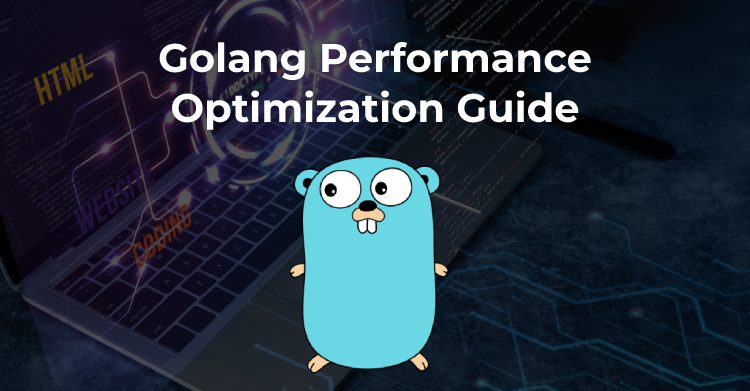
Blog
Ultimate Golang Performance Optimization GuidePosted by
Kanika Sharma on 25 Jan 2024
Golang development opens the door to a world of possibilities, especially in the era of cloud-based and server-side applications. As domains like artificial intelligence, machine learning, and data science grow exponentially, Golang is the programming language of choice for building robust and scalable applications. In this comprehensive guide designed to take your Golang applications to new heights of efficiency and effectiveness, we uncover the secrets of Golang performance optimization.
Whether you’re looking to enhance your user experience, speed up delivery, or outperform your competition, optimizing your Golang application is a critical step. This blog tackles the core issues of Golang performance, delving into the complexities of resource efficiency and operational latency. Explore with us to unlock the full potential of Golang applications.
Proven and Tested Golang Performance Tips
Bridging the gap between resource efficiency and operational latency to optimize the performance of your Golang applications requires a strategic approach. The following tips serve as beacons in the world of Golang development:
Resource Efficiency Optimization:
- Leveraging Goroutines and Channels: Using Goroutines and Channels for concurrent programming improves resource utilization and enables applications to handle multiple tasks simultaneously with efficiency.
- Memory Management Strategies: Implement innovative memory management practices, such as sync. Further, pooling for object reuse and optimizing data structures can significantly reduce memory footprint and improve overall resource efficiency.
Golang Latency Optimization:
- Profiling and Tracing: Leverage the power of built-in profiling tools like pprof to identify bottlenecks in your code. Tracing the execution flow can provide valuable insights into areas prone to delays, thus facilitating targeted optimization.
- Asynchronous Operations: Integrate asynchronous programming paradigms to reduce blocking operations and latency. Leverage features like the “Context” package for cancellation and timeout management to ensure responsive and timely application behavior.
Golang Application Performance Patterns
It is not enough to rely solely on the program compiler to optimize Go code. As well as, To enhance the performance of Golang applications, you must optimize using third-party tools and built-in packages. That’s why we’ve curated industry-leading best practices, each providing valuable insights for different application types and requirements. Also, depending on your application logic and load, you can choose from these Golang performance modes.
Optimize the use of Goroutine:
Leveraging the power of Goroutines, a distinguishing feature of Golang, adds value to the language by improving cost-effectiveness. However, be aware of the large memory footprint associated with Goroutines, which can impact application performance. Only start a Goroutine when it is known to terminate to optimize resource utilization.
Parallelize CPU operations:
Dramatically reduce synchronization times by parallelizing CPU-intensive tasks across available cores. As well as, this approach ensures that the execution speed of Go applications increases linearly.
Asynchronous I/O operations:
Resolve common bottlenecks related to network transactions and file I/O by making I/O operations asynchronous and utilizing sync. Also, WaitGroup can facilitate the synchronization of multiple I/O operations, thereby enhancing downstream latency.
Memory allocation optimization:
Avoid allocating memory in hot spots to minimize latency. As well as, reuse objects when possible and leverage sync. Pool to optimize memory usage and prevent the garbage collector from being overloaded.
Minimize the use of “cgo”:
Reduce overhead by minimizing or avoiding “cgo” functions as they incur higher operating costs and thread consumption. For optimal Golang application performance, it is recommended not to call C code in tight loops.
Buffered I/O usage:
Improve application efficiency by buffering input/output, allowing larger data blocks to be read and written, minimizing disk operation costs.
Binary text format:
Choose binary formats over text formats in PostgreSQL because they provide faster processing and efficiency during data transfer.
StringBuffer or StringBuilder usage:
Improve string processing efficiency by using a StringBuffer or StringBuilder instead of the “+” and “+=” operators, which allocate a new string on each assignment.
Regular expression optimization:
Improve application efficiency by compiling regular expressions before reuse, avoiding unnecessary processing overhead.
Pre-allocated slices:
Reduce memory waste and unnecessary garbage collection by pre-allocating slices whenever possible, thus preventing double memory allocations during reallocation.
Passing large structures via pointers:
Passing large structures via pointers optimizes memory usage and improves performance significantly when reducing memory consumption is critical.
Rotating thread strategy:
Golang’s scheduler improves performance by employing a spinning thread strategy that ensures fair distribution of operating system threads across processors. It minimizes thread migration frequency, balances CPU usage, prevents underutilization, and improves resource efficiency and speed.
Hire Golang Developers to Optimize Golang App Performance
Hire dedicated Golang developers from us to optimize the performance of your Golang application and enhance user experience. Our skilled Golang developers focus on fixing bugs and fine-tuning the application, ensuring a seamless and efficient user interface. They have the expertise to handle every aspect of Golang application development from concept to implementation.
By choosing our Best Golang Development Services, you can access a team well-versed in the latest technologies and best practices. As well as, our commitment is to empower your growth and increase customer satisfaction with a robust technology stack. Explore the vast potential of our Golang development services and hire our experienced developers to take your business to new heights.
Golang Performance – Final Verdict
This comprehensive Golang performance optimization guide is valuable in improving the efficiency and reliability of your applications. As well as, balancing performance and availability is critical, and understanding the unique needs of your application users is crucial to success. By implementing the tips mentioned above, you can improve the performance of your Golang applications through custom features.
For those looking for professional help, consider outsourcing your Golang performance optimization needs to a leading full-stack Golang application development company like Gophers Lab. Also, our dedicated Golang developers help meet your business needs, ensuring high-performing applications that perfectly fit your goals.
Share On
Tags
Golang App Performance
Golang Performance Optimization
Highlights
Download Blog

Talk to Our Experts

Get in Touch with us for a Walkthrough





